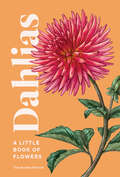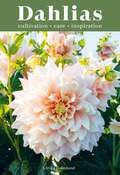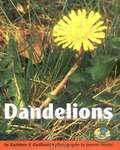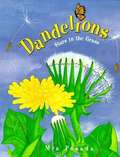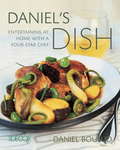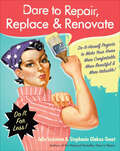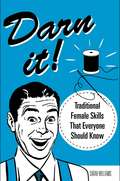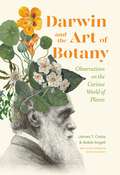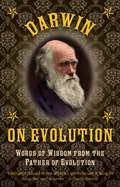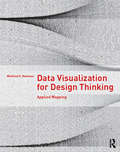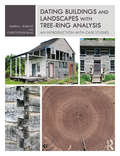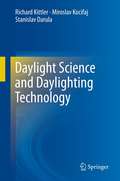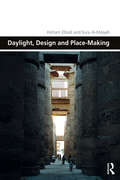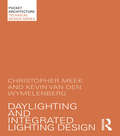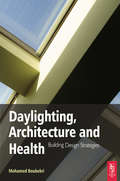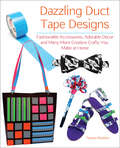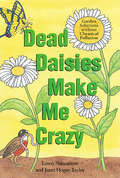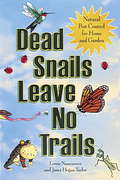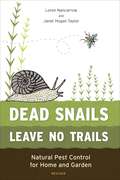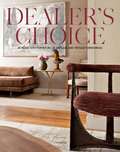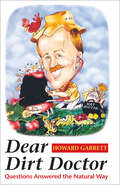- Table View
- List View
Daffodil: The remarkable story of the world's most popular spring flower
by Noel Kingsbury Jo WhitworthThere is no harbinger of spring like a field or garden filled with bright yellow daffodils. But the world of the daffodil is much more than just its place in the march of the seasons. It’s a plant whose history starts with the tombs of the Pharaohs, through pre-Darwin evolutionary theory and Cornwall’s burgeoning bulb business, and leads to the current explosion of varieties from plant breeders seeking new colors, fragrances, and forms.Daffodil reveals a global plant infatuation that has led to more than 25,000 cultivars available in nearly every shade of yellow (and now pink, orange, and white). Noel Kingsbury tells the tale through an engaging narrative history and plant portraits that highlight more than 200 varieties. Jo Whitworth's revealing photography shows a side of the daffodil rarely seen. Plant lovers will relish the stories and gardeners will cherish the cultivation notes, plant descriptions, and recommendations.
Dahlias: A Little Book of Flowers
by Tara Austen WeaverThis delightful celebration of the dahlia reads like a &“very smart love letter to cultivating beauty&” and features 60+ vintage-inspired full-color botanical illustrations (Seattle Times). &“Next time you are lucky enough to be someone&’s houseguest, consider arriving with a bouquet of either one of the Little Book of Flowers.&”—The New York TimesDahlias are the showboats of the flower world—colorful, flamboyant, and spectacular. They're also one of the most satisfying flowers to grow, with a long season, plentiful blooms, and are adaptable to most climates with proper care. They're very easy to propagate, and can be hybridized. There are numerous dahlia flower forms and more than 50,000 recognized cultivars!This charming little hardcover book includes:60+ full-color botanical illustrationsbasic botany and historyeverything you need to know to grow gorgeous blooms in the garden (including dividing tubers to propagate more flowers)tips for creating beautiful arrangements and preserving flowersquotes, lore, and notable gardens and growersLike a bouquet of dahlias, this book is an affordable little luxury for gardeners and flower lovers—the perfect hostess gift or Mother's Day present. It&’s part of the collectible mini gift book series Little Book of Natural Wonders.
Dahlias: Inspiration, Cultivation and Care for 222 Varieties
by Ulrika GrönlundLearn everything you need to know to grow dahlias successfully. Featuring a directory of 222 popular varieties each accompanied by full-colour photographs, Dahlias celebrates the many different forms of this beautiful bloom and showcases how to fill your garden with colour, texture and wildlife. This book covers all you need to know on successfully planting, growing, flowering and eventually storing your tubers for the next year. Discover the history and botany of dahlias and get inspiration for beautiful colour combinations and companion plants. An ultimate source of knowledge and inspiration for both new and experienced growers, Dahlias is a celebration of this incredible flower!
Dandelions
by Kathleen V. KudlinskiDescribes the physical characteristics and life cycle of this plant, originally brought to America by English settlers to grow in their gardens.
Dandelions: Stars in the Grass
by Mia PosadaRhyming text presents the dandelion, not as a weed, but as a flower of great beauty. Includes information about the flower, a recipe, and science activities.
Daniel's Dish: Entertaining at Home with a Four-Star Chef
by Daniel BouludDaniel Boulud, renowned French chef and long time Elle Décor contributor, shares his style of entertaining at home. Combining enticing photographs with recipes straight forward enough for even an amateur, DANIEL'S DISH is an ideal cookbook for everyone who loves to cook - and eat!
Dare to Repair, Replace & Renovate: Do-It-Herself Projects to Make Your Home More Comfortable, More Beautiful & More Valuable! (Dare To Repair Ser.)
by Julie Sussman Stephanie Glakas-TenetThe authors of Dare to Repair take on bigger DIY challenges in this easy-to-follow home renovation guide!In our first book, we taught you how to fix a leaky faucet. In this book, we teach you how to replace it. In our first book, we showed you how to change the direction of ceiling fan blades. In this book, we show you how to install a new fan. We’ve gone from basic repairs to easy projects that can make your home more comfortable, more beautiful, and more valuable. We will show you how to:Put up a tile backsplashInstall a closet systemInstall a deadbolt lockReplace a medicine cabinetMount blinds, shades, and shuttersInstall landscape lightingAnd we provide easy, step-by-step instructions to get rid of everything from ugly chandeliers to broken garbage disposals. Incorporating detailed illustrations with witty and encouraging instructions, Dare to Repair, Replace & Renovate will allow you to turn your project wish list into a can-do list.
Dare to Repair: A Do-It-Herself Guide to Fixing (Almost) Anything In The Home
by Julie Sussman Stephanie Glakas-TenetA repair guide written especially for women.
Darn It!: Traditional Female Skills That Everyone Should Know
by WilliamsCan you sew on a button? Or wrap a present? Worry not—Darn It! is here to help you master such tasks with ease to expand your repertoire and skill set, making you a more well-rounded, twenty-first-century man. Easy to navigate, this instruction manual helps you take matters into your own hands. There’s no shame in knitting your own scarf or hat, especially if it means achieving complete self-reliance. The tips and instructions in this book will teach you how to: Iron a shirt Clean your silverware Apply a bandage Use a sewing machine Make an omelet And much more! Beautifully illustrated, with clear and concise step-by-step instructions, this essential handbook is the ultimate survival guide for the modern man.
Darwin and the Art of Botany: Observations on the Curious World of Plants
by James T. Costa Bobbi AngellUncover Darwin&’s most important writings about plants with this important collection featuring expert interpretations and rare illustrations. Charles Darwin is best known for his work on the evolution of animals, but in fact a large part of his contribution to the natural sciences is focused on plants. His observations are crucial to our modern understanding of everything from the amazing pollination process of orchids to the way that vines climb. Darwin and the Art of Botany collects writings from six often overlooked texts devoted entirely to plants, and pairs each excerpt with beautiful botanical art from the library at the Oak Spring Garden Foundation, creating a gorgeously illustrated volume that never existed in Darwin's own lifetime, and hasn't since. Evolutionary botanist and science historian James Costa brings his expertise to each entry, situating Darwin's words in the context of the knowledge and research of the time. The result is a new way of visualizing Darwin's work, and a greater understanding of the ways he's shaped our world.
Darwin on Evolution: Words of Wisdom from the Father of Evolution (Cambridge Library Collection - Darwin, Evolution And Genetics Ser.)
by Charles DarwinThe father of evolution imbibed history with his controversial book On the Origin of Species. As a young scientist studying natural history, Charles Darwin set out on the HMS Beagle for a five-year voyage that would bring him in contact with animal species, plant species, and rock formations all over the world. This voyage established him as an eminent geologist, and his publication of his journal of the voyage established him as a well-known popular author. After continued, careful studying of his findings from his trip around the world, he published one of the most controversial books of history--The Origin of Species--which opposed the church’s theory that all species had come into existence at the time of the Creation. Darwin on Evolution contains quotes and wisdom from The Origin of Species, as well as from his other publications, pertaining to his theories of evolution and natural selection. Readers young and old alike will have the opportunity to learn more about his theories while also taking away important life lessons. As Darwin says, "In the long history of humankind (and animal kind, too) those who learned to collaborate and improvise most effectively have prevailed. ”
Darwin's Orchids: Then and Now
by Retha Edens-Meier Peter BernhardtFor biologists, 2009 was an epochal year: the bicentennial of Charles Darwin’s birth and the 150th anniversary of the publication of a book now known simply as The Origin of Species. But for many botanists, Darwin’s true legacy starts with the 1862 publication of another volume: On the Various Contrivances by Which British and Foreign Orchids Are Fertilised by Insects and on the Good Effects of Intercrossing, or Fertilisation of Orchids. This slim but detailed book with the improbably long title was the first in a series of plant studies by Darwin that continues to serve as a global exemplar in the field of evolutionary botany. In Darwin’s Orchids, an international group of orchid biologists unites to celebrate and explore the continuum that stretches from Darwin’s groundbreaking orchid research to that of today. Mirroring the structure of Fertilisation of Orchids, Darwin’s Orchids investigates flowers from Darwin’s home in England, through the southern hemisphere, and on to North America and China as it seeks to address a set of questions first put forward by Darwin himself: What pollinates this particular type of orchid? How does its pollination mechanism work? Will an orchid self-pollinate or is an insect or other animal vector required? And how has this orchid’s lineage changed over time? Diverse in their colors, forms, aromas, and pollination schemes, orchids have long been considered ideal models for the study of plant evolution and conservation. Looking to the past, present, and future of botany, Darwin’s Orchids will be a vital addition to this tradition.
Data Visualization for Design Thinking: Applied Mapping
by Winifred E. NewmanData Visualization for Design Thinking helps you make better maps. Treating maps as applied research, you’ll be able to understand how to map sites, places, ideas, and projects, revealing the complex relationships between what you represent, your thinking, the technology you use, the culture you belong to, and your aesthetic practices. More than 100 examples illustrated with over 200 color images show you how to visualize data through mapping. Includes five in-depth cases studies and numerous examples throughout.
Dating Buildings and Landscapes with Tree-Ring Analysis: An Introduction with Case Studies
by Christopher Baas Darrin L. RubinoThis book presents guidance, theory, methodologies, and case studies for analyzing tree rings to accurately date and interpret historic buildings and landscapes. Written by two long-time practitioners in the field of dendrochronology, the research is grounded in the fieldwork data of approximately 200 structures and landscapes. By scientifically analyzing the tree rings of historic timbers, preservationists can obtain valuable information about construction dates, interpret the evolution of landscapes and buildings over time, identify species and provenance, and gain insight into the species matrix of local forests. Authors Darrin L. Rubino and Christopher Baas demonstrate, through full-color illustrated case studies and methodologies, how this information can be used to interpret the history of buildings and landscapes and assist preservation decision-making. Over 1,000 samples obtained from more than 40 buildings, including high style houses, vernacular log houses, and timber frame barns, are reported. This book will be particularly relevant for students, instructors, and professional readers interested in historic preservation, cultural landscapes, museum studies, archaeology, and dendrochronology globally.
Daylight Science and Daylighting Technology
by Miroslav Kocifaj Richard Kittler Stanislav DarulaSunlight profoundly influences the Earth's atmosphere and biosphere. Nature fuels the evolution of all living things, their visual systems, and the manner in which they adapt, accommodate, and habituate. Sun luminance measurements serve as data to calculate typical changes in the daily, monthly, and annual variability characteristics of daylight. Climate-based sky luminance patterns are used as models in predicting daylighting calculation and computer programs applied in architecture and building design. Historically, daylight science and daylighting technology has prioritized photometric methods of measurements, calculation, and graphical tools aimed at predicting or evaluating the daylighting of architectural design alternatives. However, due to a heightened awareness of general health and well-being, sunlight exposure and freedom from visual discomfort while undertaking visual tasks are now equally prioritized. Therefore, in order to assure optimal environmental quality, daylighting technology must be based on sound science. Daylight Science and Daylighting Technology, by Richard Kittler, Miroslav Kocifaj, and Stanislav Darula, sketches the entire evolution of daylight science from atmospheric science through apt visual workplace psychophysics.
Daylight, Design and Place-Making (Design and the Built Environment)
by Hisham Elkadi Sura Al-MaiyahDaylight, Design and Place-Making examines the role of daylight in creating and revealing the wonders of heritage and contemporary architecture. Shifting from a purely technical approach to daylighting, this book places importance on the creation of meaningful aesthetics through an understanding of context and culture. Cultural applications of light in architecture differ depending on various historical, technological, and social characteristics. Increasingly, there is a revival of interest in contemporary architecture using daylight as an essential contextual ingredient in the design process. By examining the architecture of daylight in different locales and setting these in their historical contexts, the book argues that appropriate use of daylight will ensure not only visual and thermal comfort in the urban setting and aid in energy efficiency, but also will contribute to the overall identity of new buildings, particularly in urban regeneration projects. This book brings together an analysis of technical aspects of daylight performance and environmental impact, with discussions on the psychology of daylighting and its influence in shaping perceptions of our built environment. It will be an ideal read for academics and researchers interested in architecture and cultural studies.
Daylighting and Integrated Lighting Design (PocketArchitecture)
by Christopher Meek Kevin Van WymelenbergDaylighting and Integrated Lighting Design provides architects, building designers, and students clear direction for the successful inclusion of daylight and integrated electric light in buildings. It presents design teams with the performance analysis resources, energy saving estimates and user satisfaction results they need in order to make informed decisions regarding daylighting and lighting design. Written by two well-known experts in the field, the book provides: critical geometric and material relationships along with proven design process activities, offered in a quick-reference format, with sufficient context to address the range of associated issues present in any building project both the "fundamentals" and "applications" which cover design concepts and practice activities applicable to all integrated lighting projects specific directives for how the concepts covered are applied in a range of common design scenarios, including architectural rules-of-thumb, instructions for ensuring visual comfort, and preferred approaches for electric lighting control integration. In demonstrating these necessary insights to designers, the authors employ an iterative analysis of common "daylighting patterns" and illustrate and annotate both successful and unsuccessful examples via built form and simulation. Part of the PocketArchitecture series, this is the ideal pocketbook for any designer serious about reducing the energy impact of their buildings.
Daylighting, Architecture and Health
by Mohamed BoubekriDaylighting, Architecture and Health examines the relationship between natural light in buildings and human health, considering both psychological and physiological issues and bringing together a range of research in the field. As we are becoming increasingly conscious of global warming and pushing towards energy efficiency in buildings, the book examines the question of daylighting from the perspective of the health of building occupants. It gathers and reviews all the latest and pertinent medical and architectural research related to natural light, or lack thereof, and its effect on people.* Documents medical research findings which establish a link between light quality and health* Considers design strategies for increasing daylight in buildings* Develops understanding and awareness of the importance of natural light in buildingsDaylighting, Architecture and Health: Building Design Strategies is a timely and essential text for professional architects and all others concerned with the effects of daylighting on health, architecture and building design.
Dazzling Duct Tape Designs: Fashionable Accessories, Adorable Décor, and Many More Creative Crafts You Make At Home
by Tamara BoykinsCrazy cute creations made with colorful duct tape—it’s not just for repairs anymore! With eye-popping colors and exciting designs, duct tape is the most versatile and fun crafting material around. Just fold, cut and stick to make the amazing projects in this book, including:• bracelets • headbands • sandals • throw pillows • party banners • belts • purses • lunch bags • flower pens • reversible placemats • cellphone case * and moreIn addition to the decorative and useful crafts made with duct tape and just a few simple tools, you’ll even find a half dozen creative uses for your empty rolls!
De alchemie van etherische oliën: een compleet boek over essentiële oliën en aromatherapie
by Adidas WilsonEssentiële oliën bestaan in verschillende kwaliteiten. Of je nu een aromatherapeut of een consument bent, het beoordelen van de kwaliteit van essentiële oliën (EO's) is niet eenvoudig. Ze zijn afkomstig uit de hele wereld en bedrijven of leveranciers betrekken ze van groothandels of boeren wier integriteit en praktijken ze hebben leren vertrouwen. De eindconsument heeft geen idee en kan deze praktijken en relaties niet beoordelen.
Dead Daisies Make Me Crazy: Garden Solutions Without Chemical Pollution
by Loren Nancarrow Janet Hogan TaylorAt long last, you can grow your tomatoes and eat them too with the help of this primer on gardening with fewer chemicals. Gardeners and homeowners alike need simple and safe ways to stop unwanted pests and plant diseases while allowing nature to flourish. A companion to the highly successful DEAD SNAILS LEAVE NO TRAILS, DEAD DAISIES picks up where the first book left off, offering a wide range of new tips and techniques for effective organic gardening, as well as advice on how to attract beneficial wildlife to your natural space.From the Trade Paperback edition.
Dead Snails Leave No Trails
by Loren Nancarrow Janet Hogan TaylorThis comprehensive guide to controlling pests in your home and garden (and even on your pets!) is packed with simple and effective ways to avoid chemical pesticides that can kill off beneficial insects and keep useful reptiles and birds from making anyone's yard their home. Let nature's balance work to your advantage with plants that attract helpful insects and repel destructive ones, all-purpose pest repellants like garlic and chile peppers, and beneficial creatures like bats, green lacewings, hummingbirds, and lizards. Includes safe methods for eliminating ants, roaches, and rodents; ways to get rid of fleas and other critters that plague pets; and even a buying guide to the beneficial organisms you want in your garden (whether you know it or not).From the Trade Paperback edition.
Dead Snails Leave No Trails, Revised: Natural Pest Control for Home and Garden
by Loren Nancarrow Janet Hogan TaylorA practical guide to repelling indoor and outdoor pests using organic methods, updated with new information on getting rid of bedbugs and dust mites, plus includes updated online resources. If you've ever had a swarm of fruit flies in your kitchen or a gopher wreaking havoc in your yard, you may have wondered what a conscientious gardener or homeowner can do short of heavy-duty chemical warfare. Dead Snails Leave No Trails is a comprehensive guide to repelling both indoor and outdoor pests using organic methods--it's the perfect DIY solution to eliminate unwelcome visitors in your home and garden while keeping yourself,your family, and the environment safe from harmful chemicals.With a few easy-to-find items, you'll learn how to: * Make your own all-purpose pest repellents with simple ingredients like chile peppers and vinegar * Use companion planting to attract beneficial insects and animals or repel harmful ones * Keep four-legged intruders--including squirrels, deer, rabbits, and skunks--away from your prized vegetables and flowers * Safely eliminate ants, roaches, and rodents from your house or apartment * Protect your pets from critters like ticks and fleas This revised edition contains newly updated information on today's pest epidemics, like bedbugs, as well as new online resources for finding beneficial organisms that act as predators for specific pests. Full of tips, tricks, and straightforward instructions, Dead Snails Leave No Trails is the most user-friendly guide to indoor and outdoor natural pest solutions.
Dealer's Choice
by Carolyn Horwitz Craig Kellogg Anthony Iannacci Michael BrunoDealers of antiques and vintage furnishings are the ultimate design trendsetters, setting the styles that are followed by decorators, manufacturers and, ultimately, consumers. With extensive knowledge of design history and an instinct for sniffing out undiscovered treasures and diamonds in the rough, the leading dealers hand-pick the furniture, artwork and objects that personalize the spaces we inhabit.In their own homes, these dealers have the opportunity to let their imaginations run wild and to display what is, for them, the cream of the crop. With exquisite samples of rare furniture; exhaustingly curated collections of art and objects; an innate sense of taste, color, scale and proportion; and a bit of humor, the dealers design environments for themselves that can serve as compelling examples to anyone striving to create a singular home.Dealer's Choice: At Home with Purveyors of Antique and Vintage Furnishings features lush color photographs of the homes of the world's foremost antiquaires. Included are the houses, apartments, lofts, and even castles of dealers specializing in mid-century modernist furniture and objects, antiquities and antique European decorative works. These residences in New York, Los Angeles, San Francisco, East Hampton, Chicago, Paris, Istanbul and elsewhere illustrate the finest and most personal creations of the leading tastemakers in interior design.
Dear Dirt Doctor: Questions Answered the Natural Way
by Howard Garrett&“Dallas Morning News columnist and fervent advocate of the organic technique leaves no stone unturned on the subject of chemical-free gardening.&” —Publishers Weekly Howard Garrett has converted gardeners throughout Texas and beyond to gardening the natural way without chemical fertilizers and toxic pesticides. In this revised and updated edition of The Dirt Doctor&’s Guide to Organic Gardening, he uses a question-and-answer format to present a wealth of new information on organic gardening, landscaping, pest control, and natural living. The book also incorporates valuable feedback and suggestions from gardeners who've successfully used Howard&’s methods. &“This is a &‘must-read&’ for home gardeners. It should be mandatory reading for commercial growers.&” –California Garden

